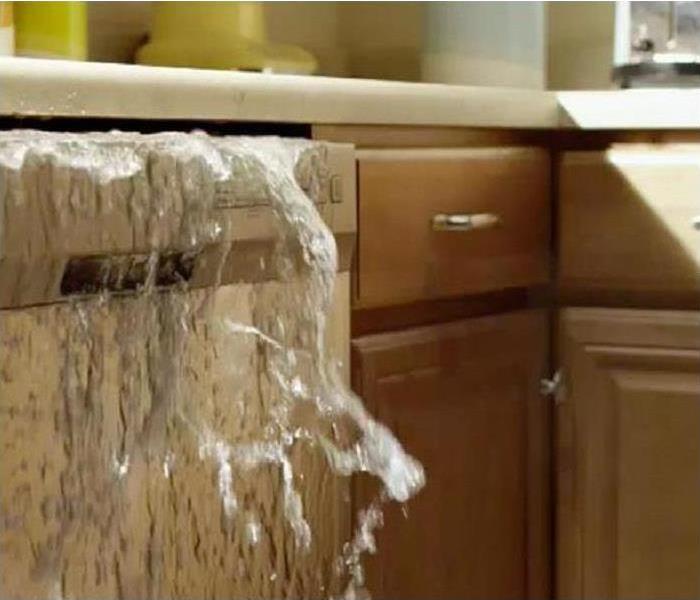Archived Water Damage Blog Posts
What are some of the tools we use to extract, dry and clean a water loss?
9/15/2023 (Permalink)
Extraction-
Some of the tools used for water extraction:
- Light Wand – used to extract water from the surface of a carpet.
- Submersible Pump- Great option for a basement that has flooded. A truck mounted extractor or portable extractor may be overwhelmed by this amount of water.
- Deep Extraction Tools- Rover
- Truck Mounted extractor-
Drying-
- Moisture Meters- are used to determine the amount of water within a material sample
- Commercial Dehumidifiers –intakes moist air, removes the water and exhausts warm, dry air into the room
- Air movers- moves warm, dry air over surfaces
Cleaning-
- Vanquish- concentrated liquid is a versatile cleaner and broad spectrum disinfectant that has multiple uses on a wide variety of surfaces. It will clean, disinfect and deodorize virtually any hard, non-porous surface.
- Water based Deodorizer with Cinnamon- This is a good deodorizer for removing the smell of smoke and soot from a carpet or wood trim
- Rainy Meadows Deodorizer- This used quite a bit for removing any final odors that might be lingering in the carpet
Stop the water first!
8/31/2023 (Permalink)
When we take in a water damage mitigation call and someone requests restoration services, once of the first things that we ask them is whether the source of the water has been stopped.
The reason for this is pretty straightforward - if there's still water coming into the structure, then stopping it is priority number one. Otherwise, we'll be extracting and re-extracting until the end of time trying to prevent further damage from occurring, and we'll never really make any progress on drying the structure out.
Of course, stopping the source is often easier said than done. If the problem has something to do with plumbing, like a burst or leaking pipe, then stopping the flow is relatively easy - just turn it off. But if someone is suffering from a roof leak, a foundation leak, or an undetermined source of flooding, then stopping the source can be complicated.
What category of water is a dishwasher leak?
8/5/2022 (Permalink)
We all like to think that we'll never have a problem with our home appliances.
Consider your dishwasher. Would you think twice about loading it in the morning before work and starting it up before you run out the door?
Most people wouldn't, and for the most part, they'd be fine. But for a fraction of the population, this exact scenario leads to disaster when their dishwasher fails or leaks and they come home to significant water damage.
What kind of water damage are we talking about? In most cases, a dishwasher leak like this is classified as a "category 2" water damage event.
Category 2 events are events where the water contains "significant contamination" and could cause discomfort or sickness if consumed. While they're not as contaminated as category 3 events, they're still very serious.
Dishwasher leaks qualify as category 2 events because the water from the dishwasher is contaminated with solids from the contents of the dishwasher, remnants of detergents and chemicals, and other contaminants that should not be consumed.
Water damage becomes more contaminated over time
8/5/2022 (Permalink)
When you have a water damage event at your home or business, you really don't have any time to waste.
Water damage should be dealt with urgently and immediately. That's because the longer it sits, the more damage it can cause, and the more dangerous that it becomes.
One example is the level of contamination of the water.
Say you have water from a clean water source - a toilet supply line, for instance. If this were to leak, it would be classified as "category 1" water damage and considered relatively uncontaminated as compared to other types of damage.
However, water that leaks becomes steadily more contaminated over time. Even if it doesn't go anywhere and just pools on the floor, it attracts and nourishes microbes, bacteria and other contaminants.
In fact, the standards published by the Institute of Inspection, Cleaning and Restoration Certification state clearly that category1 water that sits for 72 hours or more should be treated as category 3 - the same level of contamination as raw sewage.
The relationship between water and mold
6/30/2022 (Permalink)
Mold is a living thing, and it needs water just like you do.
In fact, water is one of the ONLY things that mold needs to grow (the other two being oxygen and a food source).
Usually, water is the X factor that causes microbial contamination to start to take off and get out of control. That’s why the relationship between water and mold is so well-documented.
Inside your house, mold spores usually aren’t much of a problem. They float around in the air but don’t really bother most people.
But if they land on a damp spot, or there’s an elevated amount of humidity, those spores can begin to grow and spread.
Because of this, it’s important to know that the key to fighting mold growth is moisture control.
If you remediate the mold without getting your moisture problems figured out, it’s just going to grow back and undo the work that you’ve done.
You must both clean up the mold and fix your moisture issues. Without both, you’re setting yourself up for failure.
How does a sprinkler head work?
6/30/2022 (Permalink)
In the movies, it’s a common trope to see a huge explosion of sprinklers go off in a commercial building when there’s a fire.
The implication is that, if one sprinkler head goes off, all of them go off, creating a huge mess even when the fire itself is relatively contained.
It makes for cool cinematography, but this really isn’t how sprinkler heads function in real life.
Most sprinkler heads are individually temperature-controlled, meaning that each head will only go off and allow water to flow if the temperature passes a certain threshold.
Most modern heads achieve this individual control through the use of a frangible glass bulb inside the head itself.
Inside the bulb is a tiny bit of liquid and an even smaller bubble. When heat increases, the liquid expands and the vapor compresses, breaking the bulb.
When the bulb breaks, the water inside the supply line releases and, the vast majority of the time, puts the fire out and restricts it to the initially effected area.
Pretty cool, right?
Dealing with Ice Dams
2/13/2022 (Permalink)
We have recently been getting quite a bit of snow here in Western New York. Some people love it. Others can’t wait for it to melt. The key is being ready for when it does melt. All this snow building up and melting on your roof can turn into a recipe for disaster. We aren’t just talking about the danger of icicles falling on you. Today, we’re talking about ice dams. Ice dams are the result of ice building up near the gutters on a roof which will prevent snowmelt from draining properly and can even cause a significant amount of property damage. Ice dams are known to tear off gutters, loosen shingles, or even cause water to back up into the home leaving insulation wet and creating a prime target for mold growth.
Driving around the streets of Western New York, it’s easy to see all of the giant icicles forming on almost every single building. Although they may look beautiful, they are a clear indication that water is melting off of the roof. When these large icicles form on the gutters, they leave no path for melting snow to travel off the roof. Once the water is pooled up, it will begin to soak into your roof and find any cracks or entryways that it can to get into your home. Before this can happen, it’s best to keep your gutters free and clear of ice build-up. Many people accomplish this by use of a roof rake to take large amounts of snow off of your roof.
If you do suffer water damage from ice damming, there are a few things you should do. If you think it’s worthy of an insurance claim, call your carrier and start that process ASAP. You should also contact a roofer to repair the leak so that no further water can infiltrate your home. After that, call us at SERVPRO of The Southtowns 24/7/365 for water damage mitigation – we’re here to help.
Water and the Conservation of Mass
12/10/2021 (Permalink)
Sorry if this is a recurring nightmare of yours, but we'd like to take you back to middle school science class for a second.
Specifically, we want you to think back to the day that you learned the "law of conservation of mass."
Don't remember it? Here's the Cliffsnotes: matter cannot be created nor destroyed. Mass is always conserved in any closed system.
Why are we bringing this up in the context of water damage? Because it can be a difficult thing to remember when your house floods.
Consider this example: John has a pipe burst and his kitchen floods with 50 gallons of water. John calls SERVPRO, who comes out the extract the standing water, which totals 30 gallons.
John doesn't see any remaining water, so he assumes that he's all set.
But that remaining 20 gallons of water cannot simply disappear. It had to go somewhere. And barring some kind of magic, it's safe to assume that it's still in John's house somewhere.
Most likely, that water has migrated into structural materials, like under the floor and into the walls. Some may also have evaporated into the air, causing humidity levels to rise.
Finding the hidden water and dealing with it is where the real work of water damage restoration begins. Just because you can't see it doesn't mean it isn't there - that's what the law of the conservation of mass teaches us.
Insurance Does NOT Cover All Water Damage
6/30/2021 (Permalink)
Most people assume that their homeowners insurance policy will automatically cover any water damage that they suffer in their home. After all, isn’t that what it’s for?
Unfortunately, the reality is that not all water damage is the same in the eyes of your insurance carrier. While many water intrusions are covered in full, there are plenty of examples of situations where coverage was insufficient or inapplicable to a major water disaster.
What does homeowners insurance cover?
Most policies cover water damage for which the cause is “sudden and accidental.” These situations often include burst pipes, water heater failures and other incidents that are potentially catastrophic and difficult to predict.
Your policy also likely includes separate coverage for your dwelling and your personal property. Your dwelling coverage includes the structure of your home, while your personal property coverage includes your belongings.
What doesn’t homeowners insurance cover?
Even on covered losses, most policies require the homeowner to pay a deductible out of pocket. They also usually include coverage limits – the insurance carrier is only required to pay out an amount up to the coverage limit to fulfill their end of the policy.
Generally, losses that aren’t “sudden and accidental” are not covered. If it’s determined that the damage was ongoing and could have been prevented with maintenance (e.g. a slowly leaking plumbing fixture), the damage will likely not be covered.
Dealing with the source of the water damage also likely isn’t covered. If your pipe bursts, you’ll probably pay for that out of pocket, while your policy will cover the damage from the water itself.
Water backups, like from a sump pump, often require a special type of coverage called “water back up coverage” to be paid out by an insurance carrier. Floods also aren’t covered by standard homeowners policies. If you think that there’s a chance that you’ll suffer a sump pump backup or a flood, you should call your insurance agent ASAP to inquire about how to insure yourself against this sort of damage.
Keep in mind that this blog post is just a guideline – every insurance situation is different. If you have any questions or concerns, we suggest that you call your agent before a loss happens to make sure that you’re protected. If you wait until after to start asking questions, then it’s already too late.
Don't Use Your Vacuum to Extract Water!
6/30/2021 (Permalink)
We’re not exactly sure where this misconception came from, but we hear it all the time. People seem to think that, when they have a water intrusion in their home, it’s a good idea to break out their regular, residential vacuum cleaner and try to suck up some of the water before we arrive.
Don’t get us wrong: anything that you can do as a homeowner to safely extract water and mitigate damages before a certified restoration technician arrives is incredibly helpful. It’s the best way to minimize primary damage from the water and speed up the drying process. Extraction, after all, is 1,200 times more effective than evaporation when it comes to dealing with water damage.
The key word, however, is safely. Using a regular residential vacuum cleaner to suck up water is just plain unsafe, as well as ineffective.
Think, for a second, about your vacuum cleaner functions. Most modern vacuum cleaners either have bags in which debris collects, or they have reusable plastic compartments which can be emptied once the job is done.
Even if you manage to effectively vacuum up some of the water on the ground, neither of these collection systems is designed for water. They’re not watertight, which means they’re likely to leak some or all of the water that you’ve sucked up.
That leak makes this situation very dangerous. You already should know that water and electricity don’t mix – yet if water leaks into the components of your vacuum cleaner, including the motor, that’s exactly what will happen.
The consequences can vary. Your vacuum may break down and become ineffective. It also stands a chance of electrocuting you. Neither option is very attractive.
So take it from us – don’t use your regular household vacuum on water. If you have a wet-dry vac that is specifically made for collecting water, then you may be able to use that to extract some water.
Past that, we recommend trying to soak up the water with a mop, towels or anything else absorbent. If you can’t soak it all up, you can still set towels down to impede water migration. Some homeowners have saved themselves thousands of dollars simply by setting towels down along the base of their walls so that water could not wick up into the wall chambers.
Again, the key word is safety – don’t do anything that might put you in harm’s way. The best thing you can do is call a professional restoration team like SERVPRO of The Southtowns when you need us – we’re here to help.
Restoring Water Damaged Art
6/29/2021 (Permalink)
People sometimes associate SERVPRO with a big response after water damage. We like to tell people that, if necessary, we can bring in an army of technicians and equipment to restore their home or business to a preloss condition.
But that doesn’t mean that we don’t also pay attention to the details. That goes double when it comes to restoring contents that are special, valuable or sentimental, especially water damaged art.
Can water damaged art be restored?
The restoration of water damaged art depends on many different factors. Where did the water originate? How saturated did the art or the photographs become? What, exactly, got wet? What kind of condition was it in before it got wet? Even in the best situations, restoration is rarely a sure thing.
That said, if restoration is possible, it’s often a much better alternative than simply letting the art dry on its own. Water damaged art can become stained, discolored or wrinkled very easily. If it’s framed, it might fuse to the glass. Mold can also develop, especially on photographs and paintings. Aside from the aesthetic damage, this type of damage can also cause serious health effects.
How does SERVPRO restore art?
Our restoration team has kept up with the cutting edge of art and document drying technology, combining speed of service with the highest standard of care to help our customers to retain more of their prized possessions after water damage occurs.
For most documents, photographs, and books, we utilize vacuum freeze-drying technology, as well as gamma irradiation technology for sterilization. Combined, these techniques allow us to safely dry most of the items that come our way. These are the same techniques that the LIbrary of Congress utilizes to restore documents in-house.
When it comes to other types of art, like paintings and sculptures, there are a wide variety of concerns (based on things like material, provenance and damage) that we can’t get into in detail. Suffice to say that we employ the same standard of care and specialization when it comes to restoring these valuable pieces.
If your art, documents or photographs have become water damaged, don’t hesitate to call at 716-646-6684. We’re here to help.
Tips to Save Furniture After Water Damage
6/29/2021 (Permalink)
After serious water damage, it’s important to take whatever steps that you can to salvage your structure and contents before a professional restoration team like SERVPRO of The Southtowns can get there. Among other things, furniture is a major concern. Here’s how to salvage as much of your furniture as possible:
Tips to Save Your Furniture After Water Intrusion
While every situation is different, the following tips are good rules of thumb in an emergency.
- Act fast! When you’re dealing with water damage, it’s a race against time. The longer that your furniture is exposed to water, the more likely it is to be damaged beyond repair.
- Take lots of photos. Document every aspect of every piece of furniture, including hard-to-see areas like the back and the bottom. You never know what might make the difference to an insurance adjuster.
- If you can, move furniture to a dry area. If the furniture is too heavy to move, try to put down blocks, pads or foil under the legs to protect the floor. Don’t enter an area if it is unsafe to do so, however - no furniture is worth the risk.
- Upholstery can be tough, but can often be saved if the source of the water was clean. To the greatest extent possible, separate different fabrics and colors to prevent bleeding.
- Wood furniture is more resilient and can usually be cleaned - move it to a dry indoor area as soon as possible. If exposed to sunlight, the wood may warp or crack.
- If doors or drawers have become swollen due to water infiltration, don’t force them open. Wait for them to dry.
Of course, the best advice is to leave the restoration to the professionals. The best thing for most people is to move what they can, block/pad the rest, and call SERVPRO of The Southtowns for help at 716-646-6684.
Electrical Safety After Water Damage
6/28/2021 (Permalink)
After water has infiltrated your home, safety should be your top concern. This goes double when it comes to electricity. Water and electricity don’t mix (or, they mix too well) and after a flood, there are many potential hazards that you should be aware of with your electrical system.
Electrical Safety Tips After Water Infiltration
As you might have guessed, the biggest risk that you’ll have to protect yourself against is electrical shock. The best way to keep yourself safe is to assume that, if an electrical device gets wet or is covered in standing water, it is compromised and potentially dangerous. Here are a few more tips:
- If electrical devices are covered in standing water, assume that it is already charged with life-threatening amounts of electrical current.
- Use your eyes and ears. If you see sparks or hear popping or buzzing noises, do not enter the room.
- Use your nose as well - the first sign of an electrical fire is often the smell of burning plastic.
- If electrical equipment has come into contact with water at all, don’t take an unnecessary risk - have a certified electrician clear it before using it.
Even if water damage is not visible and obvious, there’s still a chance that moisture can negatively affect your electrical system, devices and appliances. Often, this damage comes in the form of rust and corrosion that only becomes apparent long after the initial water damage has been mitigated. We recommend speaking to a certified electrician after your incident, especially if the following have been exposed to moisture:
- Wiring and circuitry;
- Switches and outlets;
- Water heaters;
- HVAC equipment;
- Major appliances (especially appliances that have motors).
When it comes to electricity and water, don’t take any risks - work with a professional restoration company and a certified professional to return your home or business to preloss condition.
Our technicians are IICRC-certified!
5/11/2021 (Permalink)
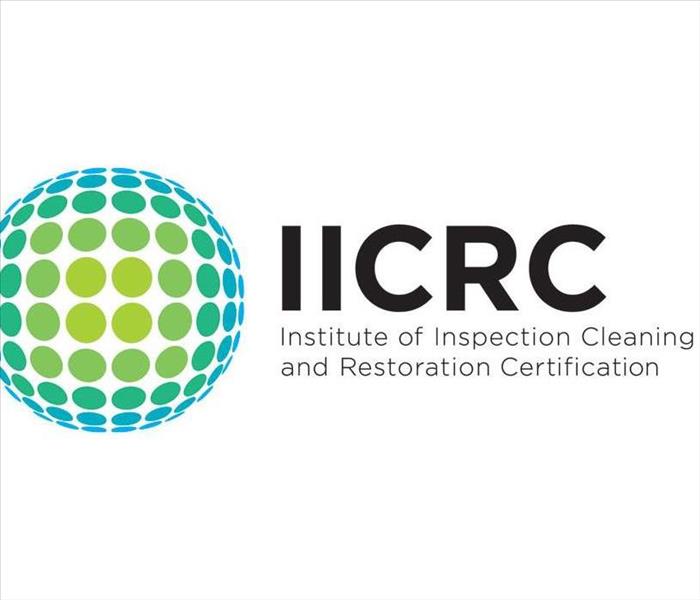 The IICRC sets the standard for the restoration industry.
The IICRC sets the standard for the restoration industry.
Here at SERVPRO of The Southtowns, each of our production technicians goes through rigorous training and certification to ensure that they understand the science of restoration.
Most of these certifications are offered through the Institute of Inspection, Cleaning, and Restoration Certification, or IICRC. The IICRC sets the industry standard for restoration, and we’re proud to say that we adhere strictly to that standard.
While many of our team members hold multiple certifications through the IICRC, pretty much everybody holds their Water Damage Restoration Technician certification. But what does that mean, and how does it benefit home and business owners? Let’s explore.
Water Damage Restoration Technician (WRT)
The IICRC’s Water Damage Restoration Technician (WRT) certification requires three days and 19 total hours of classroom work to achieve, as well as passing grades on a rigorous exam at the end of the course.
The WRT teaches not just the work that goes along with drying, but the science behind it. Technicians who get their WRT learn more about the core concept of water damage and how it can affect people’s contents and structures, as well as the most effective and up-to-date techniques out there for drying. From clean water losses to sewer backflows to post-damage contamination like mold, WRT-certified technicians are introduced to a wide array of different concepts.
The WRT is also one of the first steps an individual must take towards becoming a certified Master Water Restorer. That’s why we ensure that our technicians achieve the WRT or higher – it’s a fantastic foundation for quality work, as well as a rewarding restoration career.
Ice Dams: a Quick Primer
2/23/2021 (Permalink)
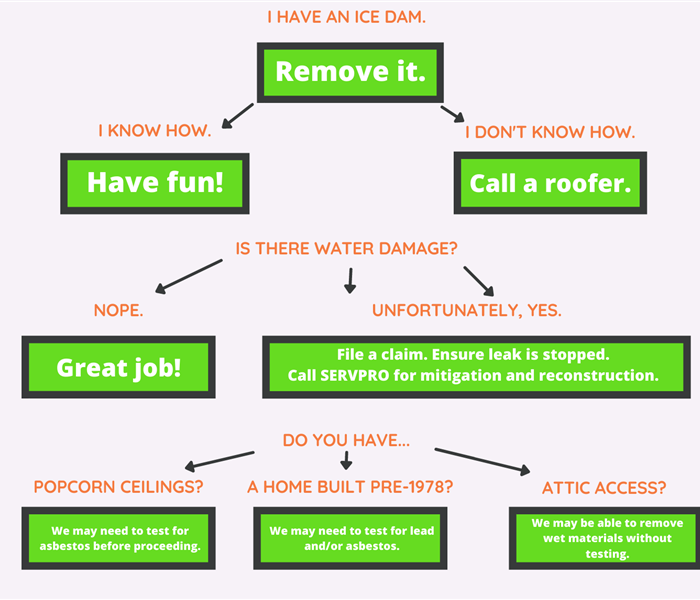 Follow this flowchart if you're dealing with an ice dam!
Follow this flowchart if you're dealing with an ice dam!
What is an ice dam? It's pretty straightforward: ice buildup on the eaves of a sloped roof that prevents snowmelt from draining properly.
Why are they bad? Ice dams:
- Can tear off gutters and loosen shingles.
- Can cause water to back up into structure.
- Can make insulation wet, making it a prime target for mold and mildew.
Bad news, right? If you have an ice dam, here's what we suggest.
What should I do if...
...I have an ice dam? If possible, remove it before snow starts to melt. If you don't have the tools (e.g. a roof rake) or the experience, call in a roofer - they'll be able to sort it out.
...water has already backed up into the house? Call your insurance office to get a claim started, then call a roofer to fix the damage. The leak must be stopped before the drying process starts in order for it to be effective. Then call in a mitigation company like SERVPRO to begin the drying process.
...there's already serious damage to my home or possessions? Same as above, but also talk to SERVPRO about reconstruction and contents cleaning. More than that, be careful - don't put yourself at risk with a sagging or compromised ceiling.
When you call SERVPRO of The Southtowns about your ice dam, we might ask the following.
Have you filed a claim? It's best if homeowners get their insurance involved ASAP.
What type of ceilings do you have? All popcorn ceilings require testing before we can open them up, though we can pick up fallen debris without testing.
When was your home built? Pre-1974, we're legally required to test for asbestos and lead. Pre-1978, just lead.
Can we access the attic? If we can, we can often remove wet insulation without needing to open up ceilings. Especially helpful if we'd otherwise need to get lead/asbestos testing.
Need help fast? Call 716-646-6684. We're available 24/7/365.
Water Damage Mitigation vs. Restoration | Process, Costs & Timelines
12/13/2020 (Permalink)
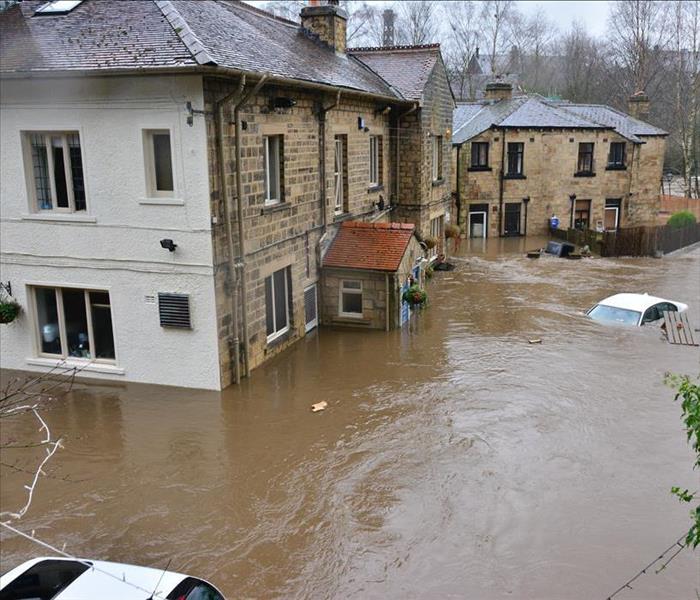 They're definitely going to need some restoration.
They're definitely going to need some restoration.
After a flood, a burst pipe, a leaking dishwasher, or any kind of water emergency, what do you need: water damage mitigation, or water damage restoration?
Often, you need both. We’ve been helping home and business owners all over Western New York recover from water damage for over 25 years from our home base here in Hamburg, and we’re proud to say we do it all (including reconstruction!).
So what’s the difference between mitigation and restoration? We’ll tell you.
Water Mitigation Versus Water Damage Restoration
Both mitigation and restoration share the goal of reducing the damage that your structure and contents suffer from water. The basic idea is that, if water damage can be dealt with quickly and effectively, much of your structure and contents can be saved instead of replaced. This helps to limit the disruption to your life that water damage can cause, as well as save you (and your insurance carrier) money in the long run.
Usually, the first thing we do when we arrive at a loss is water damage mitigation. This process is designed to prevent any further water damage from occurring. As part of our 1-4-8 Response Guarantee, we’ll be on-site within four hours of your initial call to begin the mitigation process - and usually much sooner.
Mitigation activities vary depending on the location, severity and type of water loss. Often, mitigation means extracting water, removing materials that cannot be salvaged, and drying materials that can be saved. This can often mean that some level of demolition has to occur, as in flood cutting walls to remove insulation and dry out wall cavities. This sort of work is necessary to prevent long-lasting damage to the structure, as well as mold growth.
Restoration, on the other hand, is the process of repairing, rebuilding and reconstructing after the mitigation process has ended. Restoration work can be even more varied than mitigation work, as it is entirely dependent on the type and scope of damage. If demolition was necessary, then restoration might include reconstruction. If water has sat for too long at the structure, some level of mold remediation might be necessary as well. It all depends on the emergency.
Restoration usually begins once mitigation has ended. There’s no sense in trying to restore a structure that’s still actively being damaged by water, after all.
At SERVPRO of The Southtowns, we do it all - mitigation, restoration, reconstruction and more. As full-service water damage professionals, we make the process simple and straightforward for our customers.
Scope of Water Damage Mitigation Work
It’s difficult to list out every single mitigation service we provide, as they’re so context-driven. However, we can go over some common themes to give you an idea of the scope of what we do.
Often, our first priority is protecting a structure from the elements so no more water gets in. If the roof has been damaged, we might tarp it up. If windows have been broken, we’ll have to board them up. There’s no point in starting mitigation if more water will get in before the process is complete.
Next, we’ll focus on detecting and eliminating moisture. Our powerful truck-mounted extractors can remove water from carpets and floors very quickly, avoiding serious damage from letting the water sit. Moisture meters can be used to detect water within the walls of a structure, helping us to figure out the best way to dry a building. Commercial-grade drying equipment like dehumidifiers, air scrubbers and air movers can then be placed to dry the structure - hopefully, with a minimal amount of demolition.
Finally, our team will clean and disinfect the loss site. This might entail clearing debris, like tree branches and shingles. It also often entails disinfecting and applying antimicrobial agents to inhibit the growth of mold.
Scope of Water Damage Restoration Work
The goal of restoration is just that - to restore a loss site to the condition it was in before the water emergency (or in some cases, even better condition).
Imagine if hardwood flooring was severely damaged by standing water. It’s warped and soaked, so the mitigation team pulled it out to dry the structure and remediate mold growth. The restoration team might lay down new floors once they confirm the structure is truly dry. They’ll also replace any cut or demolished walls, repair the roof and reinstall any fixtures that might have been removed. Whatever needs to happen, our restoration team can handle it.
How long do mitigation and restoration take?
Water damage mitigation and restoration are emergency services, so the faster they can safely be completed, the better. The length of time that they take, however, depends entirely on the scope of the damage.
Our 1-4-8 Response Guarantee is designed to kick this process off as quickly and effectively as possible. It breaks down like this:
- Within one hour, our on-call manager will return your call - even if you called at 3am.
- Within four hours, we’ll be on-site to begin emergency services.
- Within eight hours, we’ll provide you with a verbal briefing on the scope of work.
In that eight hour period, it’s likely that we’ll focus entirely on the mitigation side of things. Restoration can take much longer depending on the damage. An unfinished basement with stone floors is much easier to restore than a finished basement with carpets, contents and greater potential for mold growth.
If you have water damage, your best bet is to call SERVPRO of The Southtowns ASAP to get the mitigation process started. The quicker you start, the better chance you have of keeping the process short and getting your life back to normal faster.
How much does water damage mitigation and restoration cost?
Unfortunately, we can’t really answer this question - it’s like asking “how long is a piece of string?” It depends on the situation. We can, however, talk about some of the factors that affect cost.
Take, for instance, the type of water. Water damage from a clean source is inexpensive to restore compared to “black” water from a contaminated source, and more material will likely have to be replaced.
The amount of water, obviously, is also a major factor. A little bit of leakage from your dishwasher is nothing compared to a flood blowing through your window straight from Lake Erie.
The amount of time the water dwells can have a huge effect on cost as well. Water does more damage over time, but more than that, it can also lead to the development of mold if left unattended.
If you’re concerned about cost, our advice to you is this: call both SERVPRO and your insurance carrier as quickly as you can. The sooner we can get started, the more contained your costs will be. The sooner you kick the claims process off, the sooner you’ll find out the extent of your coverage.
If you’d like, we can also provide an estimate on water damage mitigation and restoration before we get started. The danger with estimates, however, is that if you wait too long to start the process, the damage will become more severe and the entire job will become more costly.
That said, if you have water damage and you’re worried about cost, call us at 716-646-6684 to talk through your options and get a sense of what the process might entail. We’ll do our best to put your mind at ease.
What is Water Damage Mitigation?
6/9/2020 (Permalink)
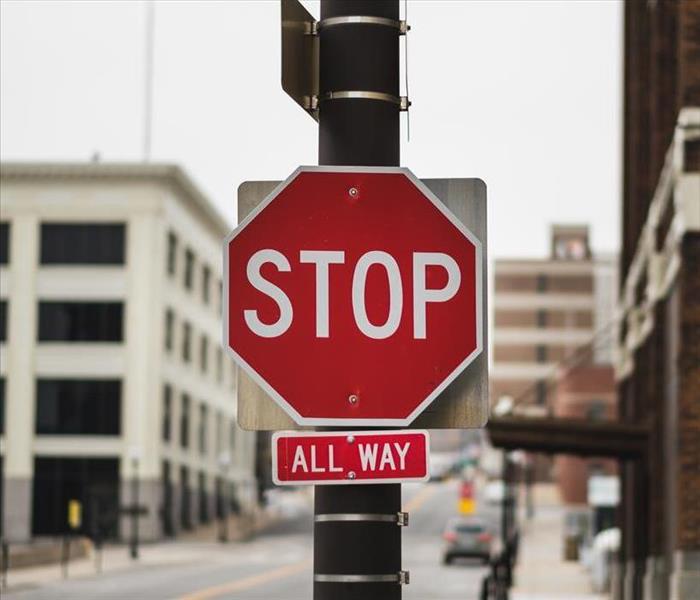 Water damage mitigation stops further damage from occurring.
Water damage mitigation stops further damage from occurring.
Unlike a professional SERVPRO technician, most people don’t go to bed at night dreaming about water damage. The average person knows that they don’t want water coming into their house, and that’s about it.
So when water does show up, in the form of a burst pipe or a failed sump pump or a backed-up drain, trying to sort through different companies offering different services can be difficult. One company offers water damage restoration, another keeps talking about water damage mitigation – what’s the difference?
If you’re reading this post, that might even describe your situation right now. So we’ll tell you: just what exactly is water damage mitigation? And how does it differ from restoration?
What is water damage mitigation?
The key difference between water damage mitigation and restoration is objective. With water damage mitigation, the goal is to prevent any more damage from happening. It’s the first step in getting you back to normal after a water loss.
“Do I really need mitigation?” you might ask. “The water’s mostly gone, things are drying out, my belongings are already soaked – why bother?”
The short answer is yes – mitigation is vitally important after any water loss. It is enormously difficult to ensure to assess the true extent of water damage on your own, and even harder to get everything dry enough that you’re not at risk of further damage or the growth of mold.
In order to prevent further damage, a water mitigation specialist might do the following:
- Remove contents, furniture, drywall and even flooring that has been damaged;
- Assess the structural stability of a building;
- Extract remaining water using special tools and machines;
- Work with you to figure out what contents are salvageable, and then clean and disinfect those contents;
- If necessary, board up windows and tarp roofs to ensure that no more water gets in.
In short, water damage mitigation is about stopping any further damage from occurring so that the restoration process can begin.
If that’s mitigation, then what is water damage restoration?
Good question! And a common one – many people don’t realize just how extensive the process of cleanup and restoration can go.
Water damage restoration mostly focuses on rebuilding your home or business. At this stage, whatever damage that occurred before mitigation will now be addressed. The restoration stage is where the pros here at SERVPRO of The Southtowns really shine at making it “like it never even happened.”
The actual work that restoration entails really depends on the type and extent of the damage. Standing water in a basement is a much different beast than a hole in a roof, after all. Still, you might expect to see the following:
- Replacement of any walls or floors that had to be removed;
- Detection and removal of any mold that might have formed;
- Repair of any structural or roof issues that might lead to more water damage;
- Extensive humidity and moisture testing to verify that the water problem has been solved.
If you’re still having trouble remembering the difference between mitigation and restoration, just remember this: mitigation stops the problem and restoration reverses it. And if you ever need a mitigation or restoration team to help you after water damage strikes, call SERVPRO of The Southtowns at 716-646-6684 – we’re here to help!
9 Emergency Water Damage Tips
6/9/2020 (Permalink)
 Tip #7: get your art out of there!
Tip #7: get your art out of there!
As water damage mitigation and restoration professionals, we know firsthand that the first 24 hours after a water loss are the most critical for reducing and preventing damage. The steps you take immediately after a loss will determine whether the damage is minor or major, temporary or permanent.
That’s why, after you call us, we spring into action fast. We get to you ASAP to inspect the scene, provide emergency mitigation services, monitor drying and restore your home or business to preloss condition.
But what should you do when a water loss occurs? How can you spring in to action to prevent permanent damage? Here are nine simple tips.
- Do not enter area if water is exposed to electricity.
Before you rush in and get to work, make sure it’s safe. If there’s a chance that the water might be exposed to a live wire or an electrical source, do not enter the room.
- Do not enter area if ceiling is sagging, and do not turn on wet ceiling fixtures.
Similarly, don’t rush into the area if the ceiling is sagging – this might indicate more serious structural damage, and there’s no reason to put yourself in harm’s way. You should also avoid turning on any ceiling fixtures if the ceiling’s wet.
- Shut off the water source, if possible.
If you can safely access the water source, shut it off to prevent further water from coming into your home or business. If you aren’t sure how to access the water source, or you aren’t sure if it’s safe, call a qualified professional for help.
- If safe, turn off circuit breakers for wet areas.
If you’re able to get to them safely, you should also turn off the circuit breakers for the wet area to prevent the flow of electricity.
- Mop or blot as much excess water as you can.
In a water loss, every little bit counts! Grab your mop and whatever towels you can find and try to remove as much water as you can until the professionals get there.
- Place foil or wood blocks between furniture legs and wet carpet.
If possible, you can also remove the furniture from the room altogether.
- Move art, electronics, documents and valuables to a dry place.
Moving contents to a dry place is the first step to restoring them to their original condition. Start with art, electronics, documents and anything else that’s both especially valuable and susceptible to serious damage.
- Do not use a household vacuum to suck up water – this could shock or damage the device.
Some people try to use their vacuums as makeshift extractors. We don’t recommend it – you’re likely to damage your device irreversibly.
- Call us, we’re here to help!
No matter how fast you spring into action, there’s a good chance that you’ll need professional help to truly mitigate and restore serious water damage. Give SERVPRO of The Southtowns a call at 716-646-6684 – we’re here to help!
Why Do Basements Flood?
6/9/2020 (Permalink)
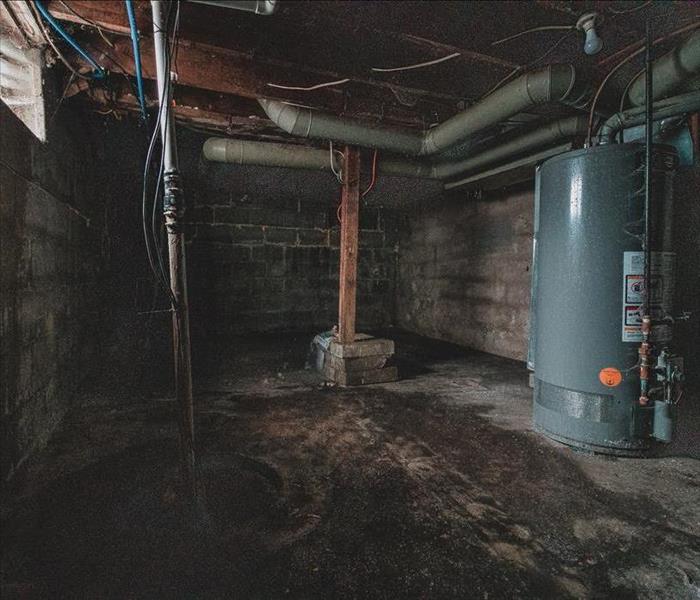 Water flows to the lowest point it can find. That just might be your basement.
Water flows to the lowest point it can find. That just might be your basement.
If your basement floods every single time there’s a rain storm in Western New York, you might ask yourself “Why me?” when you flip on the light and discover puddles of water downstairs.
You might also ask yourself “why do basements flood in the first place, and is there anything I can do to stop it?” We’re here to help you answer those questions as best we can.
First, blame gravity.
Let’s get the obvious out of the way. Basements are the base of your home or business, built at least partially into the ground. They’re at the bottom – of course gravity is going to pull water in their direction. Water has to flow somewhere, and it tends to flow to the lowest point it can find.
So that’s the simple answer: basements are lower than the ground, so if water is going to flow somewhere in your house, that’s where it’ll end up.
But why does your basement flood in particular? Why does this happen to you, and not your boss or your brother-in-law? Let’s examine some common causes of basement flooding.
Common Causes of Basement Flooding
Often, flooding occurs due to a lack of proper drainage. Say your home is not graded correctly, or that your gutters are clogged. Problems like these will cause water to pool and not drain away, eventually finding its way into your basement.
It’s easy enough to clean your gutters. But if there’s an issue with your foundation drainage system, you might be in trouble. If your foundation and basement do not have a proper system in place to move water away, then water is going to seek out any cracks it can possible find in your basement walls and pool up in your basement.
Of course, drainage isn’t the only cause of basement flooding. Very often, serious floods are caused by the very systems designed to prevent the buildup of water. If your sump pump isn’t working correctly, for instance, or if it isn’t capable of keeping up with heavy rainfall, you’re likely to see flooding.
Backed up sewers can also be a huge problem. If sewers themselves are backed up or start to overflow, sewage can flow back towards your house and back up through a toilet or drain – not a fun cleanup.
Can the causes of basement flooding be fixed?
The good news is yes – if you can figure out why your basement is flooding, you should be able to fix the core issue. It just might not be easy.
If the issue is improper grading, for instance, a landscaper should be able to figure out how to fix it. If you’re more of a DIYer, and the issue isn’t enormous, you may be able to create a proper slope yourself with nothing more than a shovel, some soil and some elbow grease.
Clogged gutters are also easy enough to diagnose and clean. A good rule of thumb is to clean them out twice a year (once in the fall and once in the spring). Obviously, if you think they’re clogged, you may want to clean them out sooner than that.
Broken or underperforming sump pumps can also be replaced and repaired. If you think you have a sump pump issue, call a professional – they should be able to help you to figure things out. It’s also not a bad idea to install backup power for your sump pump so that it can continue to function even if you lose electricity in a storm.
As for sewage backups, all you can really do is install a one-way drain plug. While you can’t prevent local sewers from backing up, installing a plug should at least help to prevent a backup from entering your basement somewhat.
And if the issue is cracks in your foundation, you’ll very likely want to call in a pro, and fast. Cracks only get worse over time and can sometimes be difficult to locate. A professional should be able to help you to solve your problem for good.
So next time your basement floods, don’t ask yourself “Why me?” Ask yourself “What can I do to make sure this never happens again?” You’ll be glad that you did.
The Categories and Classes of Water Damage
6/9/2020 (Permalink)
 Back to school! The topic today: categories and classes of water damage.
Back to school! The topic today: categories and classes of water damage.
You already know, intuitively, that certain types of water damage are more severe than others.
A spilled water bottle? No big deal. A city sewer backing up into your basement? A total disaster. A hurricane parking itself right over your city? Just about as bad as it gets.
But did you know that there are pre-determined categories and classes that professionals use to assess water damage quickly and accurately? These classifications provide a useful shorthand for pros to communicate the extent of damage to each other. They also help them to quickly come up with effective mitigation and restoration plans based on prior experience.
We’ll walk you through the standard categories and classes so you can see for yourself just how unique each water loss can be.
Water Damage Categories
The categories of water damage refer mostly to the type of water present at the loss. Understanding the quality of the water is the first step in coming up with an extraction and mitigation plan, as it determines which tools should be used and what processes should be followed.
“Category 1” is the least severe. This category refers to water that is either clean or at least adequately sanitary that it would not pose a threat to a person if accidentally ingested. Say your sink overflowed – since you’re basically dealing with the water that came right out of your tap, it’s probably a Category 1.
“Category 2” is what professionals refer to as “gray water.” This water might be contaminated with microorganisms and should be treated with caution, as it might cause issues if ingested. Gray water might come from a broken toilet or a failing sump pump.
“Category 3” means “black water,” which is about as unsanitary as it gets and likely contains bacteria and other organisms that could cause serious illness if accidentally ingested. The most obvious source of black water could be a sewage backup, though water that has been standing for long enough may also be adequately contaminated to qualify as a Category 3.
Now you can imagine why establishing categories is important – it lets a professional know what they’re dealing with before they arrive on the scene.
Water Damage Classes
While the categories refer to the type of water, water damage classes have more to do with the rate of evaporation, the amount of water present, the size of the area affected and the ease of drying.
“Class 1” is the least severe class of damage. A Class 1 loss would affect only a small area inside a home or business, and it would consist of a small amount of water. Drywall, flooring and carpet would be minimally affected by the water and minimal drying equipment would be necessary.
“Class 2” is more severe – you’re likely dealing with an entire room that has been affected. The water likely came up from the floor, though it may have also wicked up the walls. Drywall, carpet and flooring would also be affected and may need to be torn out or removed depending on the category of the water.
“Class 3” is the most severe. Water in a Class 3 loss generally comes from overhead and affects just about everything in the area of the loss. A Class 3 loss often involves a greater amount of demolition and reconstruction, especially since the ceiling is likely to be affected.
“Class 4” refers not so much to the severity of water damage as the type of material affected. Class 4 water losses involve specialty drying techniques designed to dry out specific materials like stone, hardwood and plaster.
And there you have it – the 3 categories and 4 classes of water damage. No matter how your water loss is classified, we’re here to help. Call SERVPRO of The Southtowns at 716-646-6684 when you need us.
Water vs. Wood - What Stands Up Best?
6/9/2020 (Permalink)
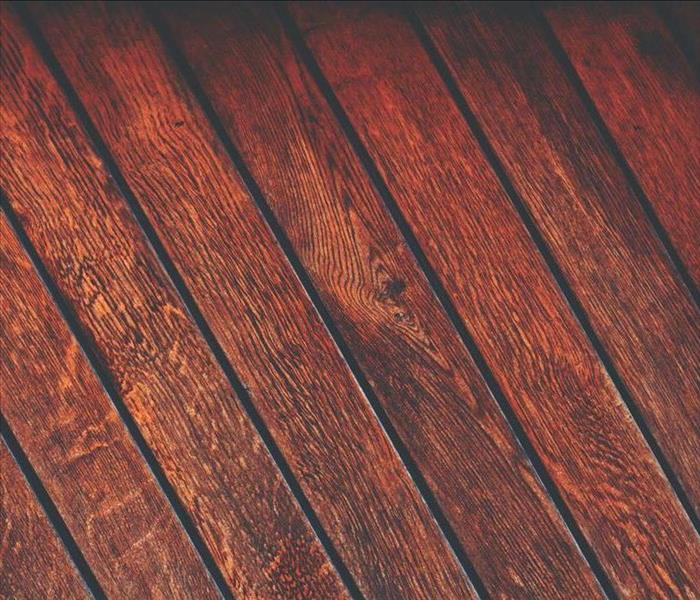 The type of wood you use in your home matters.
The type of wood you use in your home matters.
There’s a lot of scientific research out there examining the relationship between water and wood. The reason for this is simple – basically everything we build has wood in it, and moisture is everywhere, but most of the issues we encounter with wood or wood products can be traced back to water in some way.
That’s because wood is a hygroscopic material, which is a fancy way to say that it tends to equalize moisture levels with its environment. In a wet environment, wood will take on moisture. In a dry environment, it will give off moisture. You can contrast this with non-hygroscopic materials, like PVC, which do not absorb moisture internally even as it gathers on the surface of the material.
Of course, not all wood is created equal – different types of wood have different properties. If you’re considering using wood for a project but are concerned about moisture or future water damage, read on to learn more about what type of wood you might want to use.
First: what happens to moist wood?
Wood that’s exposed to moisture can suffer from a variety of different problems, including:
- Shrinkage/expansion: shrinking or growing in a certain direction, depending on the grain;
- Warping: shrinkage/expansion in a particular area of the wood, which leads to the wood changing its shape;
- Rot/decay: development of fungi in moist areas, which leads to deterioration.
In other words, wood exposed to moisture can change its shape, change its aesthetic and deteriorate over time. That’s why it’s so important to choose the right wood for your project. Here’s a brief rundown of common types of wood and how they stand up to water damage and moisture.
Mahogany
Mahogany’s a beautiful wood, and it can stand up to moisture extremely well. That’s why they use it to make boats, and that’s a big part of why it’s so expensive. Still, with its gorgeous reddish-brown hue and its serious resistance to warping, welling and shrinking, it’s easy to understand why so many homeowners choose mahogany for their projects.
Walnut
Walnut is also a popular choice for similar reasons. It’s easy to work with, so people often use walnut for things like furniture and cabinets, but it stands up strong to shrinking and warping as well.
Teak
Teak is used in a wide variety of places. You can build a ship with teak, you can build a floor with teak, and you can use it for a wide variety of construction projects. No surprise, then, that its known for its ability to resist warping, cracking, decay and rot in the face of moisture.
Oak
Like mahogany, oak is popular for everything from boats to floors. It’s easy to understand why – it’s flexible yet hardy, it finishes well and it can stand up to absorption and warping in the face of moisture.
Cherry
Cherry is popular for its aesthetic – among other things, it reddens when exposed to sunlight, which some homeowners like. Cherry is also highly resistant to warping and shrinking, and it’s a good choice for furniture and cabinets.
Pine
The softness of pine makes it easy to work and a popular choice for many furniture makers. It doesn’t hurt that it also resists shrinkage, swelling and warping when exposed to moisture.
Maple
Maple is used in both flooring and furniture quite often, but it’s not as resistant as mahogany, walnut or oak. Maple is likely to shrink if it is consistently exposed to water or moisture. If you have maple furniture or flooring, make sure that you protect it from humidity as best you can.
Spruce
Spruce is popular for a few specific uses. It’s strong, soft and often used in mills and even in the construction of aircraft. But while it is highly resistant to decay, it can experience shrinkage over time.
Cedar
Soft, reddish cedar is sought out for its uniform texture and often used for fence posts, planks and even furniture. How well does it stand up to moisture? Moderately – its resistant to decay, molding and rot, but tends to shrink and expand over time.
Keep in mind that while some types of wood can stand up to moisture better than others, any amount of water damage is going to be a problem for wood. If you have a water problem at your home or business, call SERVPRO of The Southtowns at 716-646-6684 today!
Nine Tips for Creating Water Damage Mitigation Plans
5/26/2020 (Permalink)
 Taking the time to make a detailed plan with all stakeholders pays off in an emergency situation.
Taking the time to make a detailed plan with all stakeholders pays off in an emergency situation.
Do you have a water damage mitigation plan in place?
You might not realize it, but water can be one of the most destructive things that your property could ever face. When water finds its way into an environment that was not designed to be wet, lasting damage can occur very quickly.
In fact, according to Zurich North America, water losses cost up to three times more than insurance claims that do not involve water. The bulk of these losses, according to CNA, come from damaged water supply lines – specifically, burst pipes during cold weather.
The takeaway: a water loss can happen just about anywhere, without much warning. That’s why having a water damage mitigation plan is so important. With a documented process for dealing with water damage as it happens, you’ll be able to react much more quickly and minimize the long-term consequences of your disaster.
Here are nine tips for creating your plan:
1. Find your leader.
A clear chain of command ensures that your organization will be able to act quickly in a crisis. Choose a leader who you can trust to react quickly, delegate intelligently, document thoroughly and implement your plan completely.
2. Break your plan down with specifics.
Don’t just come up with a general checklist for mitigation. Devise a specific and detailed plan for each building or area that you’re responsible for, with designated responsibilities for particular employees who will be able to spring into action in a crisis situation 24 hours a day.
3. Know your detectors.
Go into detail about how a problem might be detected. Will you perform regular manual checks and inspections? Will you perform specific checks after a severe weather event? Do you have automatic detection methods that you’ll rely on as well?
4. Study your schematics.
Even if you think that your employees know your building like the backs of their hands, it pays to make sure that key personnel pull and study your interior and exterior schematics. They should pay special attention to piping, sprinklers, pumps, valves, electrical breakers and gas shutoffs.
5. Photograph and label all shutoffs.
Use standardized tags to label each shutoff valve, and include photographs of the valves in your plan. This step ensures that there will be no confusion about what gets shut off when in an emergency.
6. Make a checklist for every eventuality.
How will you respond to a sprinkler leak? A flood? A burst pipe? Will those processes differ in any way? If so, make sure that you include specific instructions for each.
7. List emergency numbers for all vendors.
Make a list of trusted vendors that will be able to respond in an emergency situation and jot down their contact information in a consolidated place. This list might include plumbers, roofers, electricians, contractors, insurance agents, alarm companies and local authorities. By choosing your go-to vendors before an emergency takes place, you’ll greatly improve your ability to make decisions quickly.
8. Stock emergency spill and pipe repair kits.
Work with your maintenance team to put together kits to deal with spills and burst pipes as soon as they occur. These kits should include your mitigation plan along with things like sheets to cover electronics, small portable pumps, fans and other tools that can minimize water damage quickly as you wait for professional help to arrive.
9. Communicate!
Don’t just expect your staff to read, internalize and use the plan you create. Set a meeting to go over the plan in detail with everyone involved, especially those who may need to enact the plan in your absence. Don’t assume that you’ll be on-site to manage every disaster – accidents tend to happen when we’re least equipped to deal with them.
Still not sure how to move forward with your water damage mitigation plan? Don’t worry – we can help! Call 716-646-6684 today and ask how we can help you to put together an Emergency READY Profile, free of charge.
Important Things To Know About Your Water Loss: Categories of Water
6/21/2019 (Permalink)
You already know that water damage can be extremely devastating and damaging, but did you know that there are different categories of water? Yup, that’s right. These three different categories of water help determine what our drying plan will be, and what products need to be used in order to properly sanitize and clean the disaster.
Category 1- This is clean water that is free of contaminates or additives. It can be water that originates from the plumbing supply line, the toilet supply or sprinkler head.
Category 2- This is grey water and it contains significant contamination. It may have additives; it may have passed through building materials or has remained stagnant for a short period of time. Category 2 water is usually from sump pump failures or floor drains. It is also Category 1 water that has passed through walls or floors, or Category 1 water that has sat for more than 72 hours.
Category 3- This is black water and is grossly contaminated water or sewage. It is water that originates from flooding, beyond the plumbing trap or has remained stagnant for a long period of time. It is usually from a sewer drain backup, flooding, or is Category 2 water that has sat for more than 48 hours. This type of water requires our technicians to wear full PPE while extracting, and extensive cleaning and sanitizing after the water is removed.
Once one of our professional technicians has determined what category the water is, they can begin to put together an appropriate plan to make your water damage, “Like it never even happened." If you have any water damage in your home, please call the experts of SERVPRO of The Southtowns at (716) 646-6684.
Be In The Know: Categories of Water
6/18/2019 (Permalink)
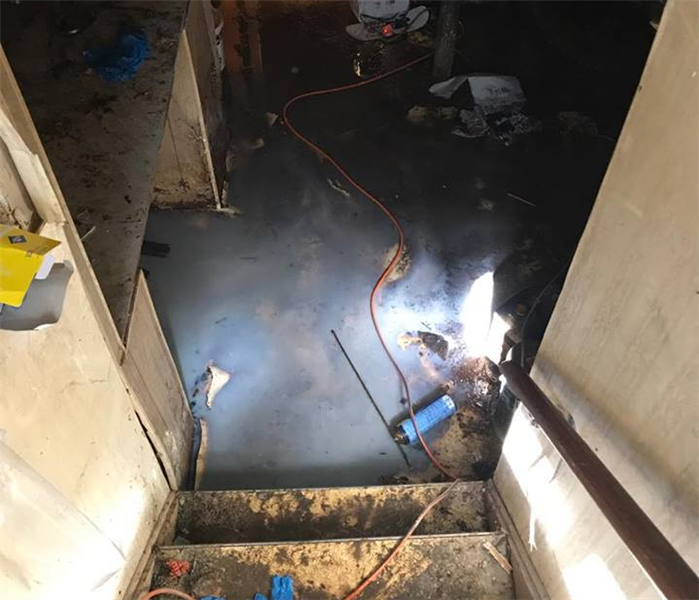 Determining the proper category of water is critical to determining the best drying plan for your water damaged home or business.
Determining the proper category of water is critical to determining the best drying plan for your water damaged home or business.
You already know that water damage can be extremely devastating and damaging, but did you know that there are different categories of water? Yup, that’s right. These three different categories of water help determine what our drying plan will be, and what products need to be used in order to properly sanitize and clean the disaster.
Category 1- This is clean water that is free of contaminates or additives. It can be water that originates from the plumbing supply line, the toilet supply or sprinkler head.
Category 2- This is grey water and it contains significant contamination. It may have additives; it may have passed through building materials or has remained stagnant for a short period of time. Category 2 water is usually from sump pump failures or floor drains. It is also Category 1 water that has passed through walls or floors, or Category 1 water that has sat for more than 72 hours.
Category 3- This is black water and is grossly contaminated water or sewage. It is water that originates from flooding, beyond the plumbing trap or has remained stagnant for a long period of time. It is usually from a sewer drain backup, flooding, or is Category 2 water that has sat for more than 48 hours. This type of water requires our technicians to wear full PPE while extracting, and extensive cleaning and sanitizing after the water is removed.
Once one of our professional technicians has determined what category the water is, they can begin to put together an appropriate plan to make your water damage, "Like it never even happened." If you have any water damage in your home, please call the experts of SERVPRO of The Southtowns at (716) 646-6684.
Did You Just Experience a Water Loss? Read This!
6/7/2019 (Permalink)
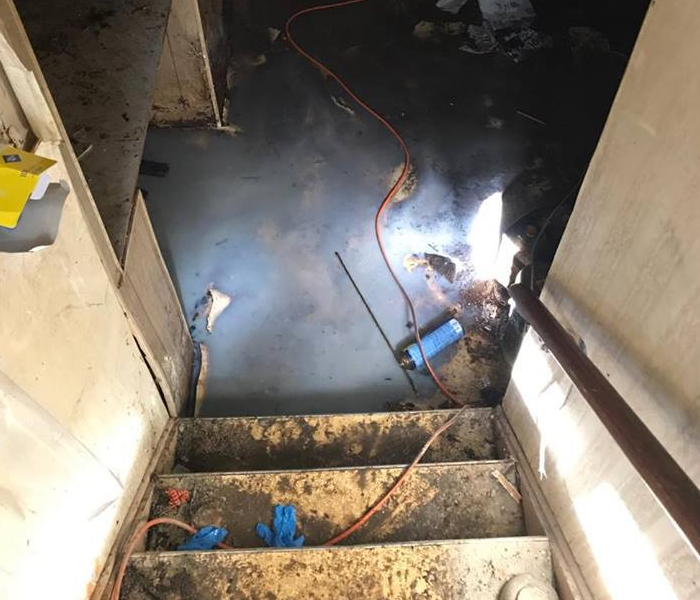 We can now restore ALL of your contents! Soft goods included.
We can now restore ALL of your contents! Soft goods included.
The aftermath of a fire can be one of the most devastating times of a person’s life. It is not uncommon for someone to want to feel a sense of normalcy immediately after a fire. You already know that SERVPRO of The Southtowns can take care of the cleanup and restoration of your fire damaged home, but we can now help you with the restoration of your soft goods and textiles too.
What do we mean by textiles? We mean we can restore most, if not all, of your
- Sports equipment
- Soft contents (such as stuffed animals)
- Laundry
- Shoes and handbags
- Curtains
- And so much more
In fact, we are now able to restore 90% of the soft content items in your home and nearly twice as much soft contents than a restoration drycleaner! We can restore items affected by heavy soot, Category 2 & 3 water, mold and bio contamination. And, we can do it in as soon as 48 hours. That means you can get back to normal life even faster! This also means having just one point of contact for all your restoration needs, which helps to make life a little easier during your time of need. Just another way we are, “Here to help” and make it, “Like it never even happened."
If you experience fire damage, please give our office a call at (716) 646-6684 and let the professional experts at SERVPRO of The Southtowns get life back to normal.
One Day It Just Started Raining, And It Never Stopped...
5/20/2019 (Permalink)
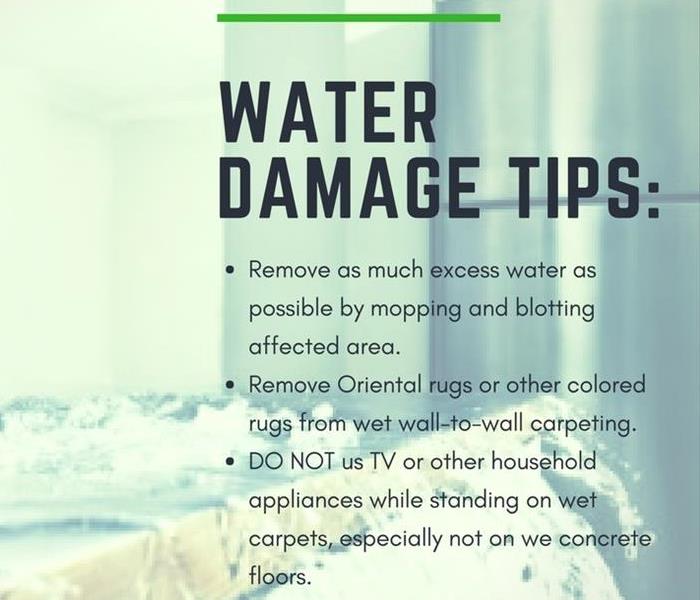 When storms are in the forecast, be sure to take preventative measures so that the rain and water stay outside and not in the home.
When storms are in the forecast, be sure to take preventative measures so that the rain and water stay outside and not in the home.
Will it ever stop raining? That seems to be the question lately. And while the weather outside is anything but desirable, it’s important to remember to take preventative measures inside your home to help prevent water damage.
A simple, and affordable way to help protect your home during these rain storms is to purchase a water detection alarm to place near the sump pump. You can purchase one of these devices from any local hardware store, Home Depot or Lowes. They can be purchased for as little as $10, and are worth every penny.
Another action you can take is to check the attic and crawl spaces for any water that may have been dripping and accumulating. Any time there is accumulated moisture, warmth and a food source (such as wood, cardboard or other soft goods) there is potential for mold growth. Taking away one of these factors eliminates the chance for mold. By staying proactive, you can help prevent mold growth in your home.
Lastly, you can run a dehumidifier in basements or crawl spaces that hold a lot of moisture. This is a pretty common tip that most people follow this time of year, but it’s one that is worth sharing. Dehumidifiers help pull moisture out the air and keep your basement and contents in it dry.
If you do discover water damage from these storms, it is important to call a professional as soon as possible. Water damage is not something that should be “cleaned up” by a nonprofessional. Items or parts of your home that seem dry may actually still be wet, which can lead to more damage down the road. Not to mention the water (depending on where it came from) can be loaded with contaminants. Should you experience any water damage during these rain storms, please give our office a call at (716) 646-6684 and let SERVPRO of The Southtowns make it, “Like it never even happened."
Do You Need CE Credits? We Got You Covered!
4/11/2019 (Permalink)
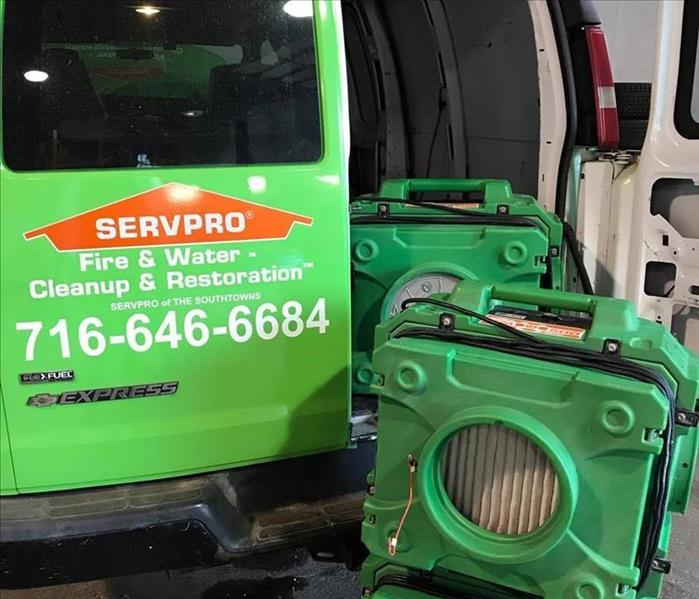 Need CE Credits? Come to our class on May 7th, 2019.
Need CE Credits? Come to our class on May 7th, 2019.
SERVPRO of The Southtowns Presents a breakfast seminar covering
“Water Damage: Risk, Diagnosis, & Mitigation”
CE Credits (3) available for NYS Insurance BR, PC, C3, PA
Course # NYCR-259587
Date: May 7, 2019
Time: 9:00 AM – 12:00 PM
Registration and Breakfast: 8:30 AM
Location: JP Fitzgerald’s
4236 Clark St. Hamburg, NY 14075
Course fee: $60.00 (Fee Waived by SERVPRO)
Complimentary Buffet Breakfast Provided!
What Will You Learn?
- The significance of water damage.
- Causes & effects of excessive moisture on structure, contents, and health.
- How quickly microbial (mold) growth can appear as a result of excessive moisture.
- What your insured experiences with a water loss.
- Emergency tips that can be given by phone to keep the loss at a minimum.
- How fast action, in handling water loss claims, will save money & property.
- The procedures that mitigation companies utilize to detect, mitigate, and document water losses.
- The state-of-the art equipment is now used in mitigating water damage.
- How ground water and sewage claims are handled.
- Special restorative techniques for documents, electronics, and artwork.
- New claims handling procedures, documentation requirements, vendor relationships.
Contact our office if you are interested in attending at (716) 646-6684.
3 Tips for Filing an Insurance Claim after You’ve Experienced Water Damage
3/11/2019 (Permalink)
 Having water damage in your home or business is stressful enough, filing an insurance claim shouldn't be.
Having water damage in your home or business is stressful enough, filing an insurance claim shouldn't be.
Discovering water damage in your home is stressful enough, filing an insurance claim shouldn’t be. So here our top three tips when it comes to filing an insurance claim for water damage. These tips and tricks come highly recommended from our top Insurance Agents, and make the claim processes faster and easier.
- Stay Calm and Carry On-It may sound simple, but staying calm during the claim process can make a huge difference. By keeping your emotions in check, you will be able to better communicate and describe the damage to your insurance agent, hear what they are saying with clarity and also not miss any important information they are trying to share with you. We recommend that you keep a list of phone numbers on your fridge (ex. SERVPRO of The Southtowns, your Insurance Agent, and the local Fire Department) just in case of an emergency. Remember, it’s always best to be prepared.
- Snap Some Photos- Taking photos of any water damage or standing water is ALWAYS a good idea. It allows the insurance company to see firsthand the extent of the damage, as well as help protect you should a question arise. These days most people carry their smart phone on them at all times, so having access to a camera is no problem!
- Speak Up!-Dealing with a water loss claim can feel overwhelming at times. If you ever have a question about what is going on be sure to ask. Our office staff is here to explain and answer any question you may have. ALL of our technicians are IICRC Certified, and can answer any questions you may have onsite. Here at SERVPRO of The Southtowns we understand that this may be your first water loss and we are always available to help our customers.
We would like to point out that every insurance policy is different. So be sure to call your Insurance Agent prior to filing a claim, to determine if there is coverage for your water loss and policy details. If you are questioning if you currently have coverage for a water loss, give your local Insurance Agent a call and schedule a review of your policy.
How To Prevent Frozen Pipes This Winter
1/18/2019 (Permalink)
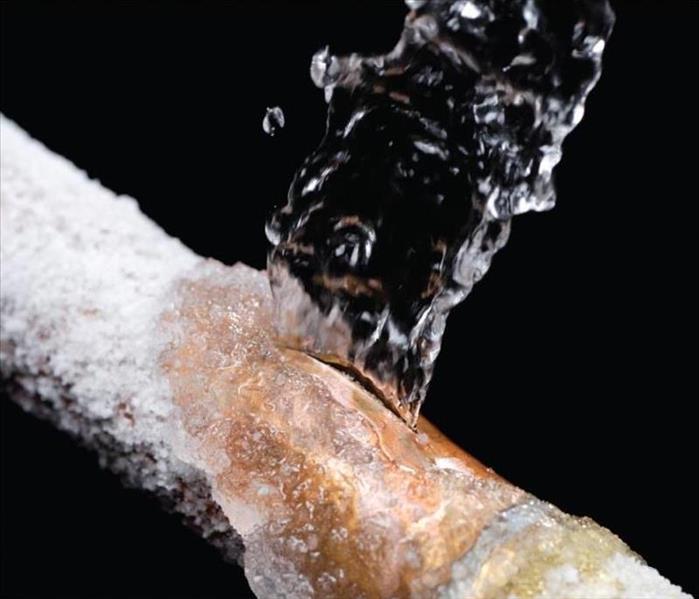 Use these preventative measures to prevent frozen pipes in your home this winter.
Use these preventative measures to prevent frozen pipes in your home this winter.
January is here, and so is the frigid temperatures. Also, it’s the time of year Western New Yorkers like to travel to a warmer climate to escape the cold. If you are planning your winter escape, it is important to take preventative measures to prevent the pipes in your home from freezing. Water damage from a burst pipe can be devastating, and costly. Especially when the water is sitting stagnant in the home for more than 24 hours, this leaves the potential for mold. Here are a few tips to prevent the pipes in your home from freezing.
- Keep the furnace running at 55 degrees-Turning the heat down when you are away from the home for an extended period of time is smart, but be sure the thermostat does NOT go below 55 degrees.
- Insulate pipes exposed to outer walls-This gives pipes that are more prone to freezing added protection.
- Allow water to flow through pipes by turning on faucets to a slow drip-This keeps water moving consistently through the pipes.
- Open cabinets to allow heat from inside the home to help keep pipes warm-The extra air flow will help prevent the pipes from freezing.
Should you come home and find that a pipe is frozen, take immediate action to thaw it. If you experience water damage from a pipe that froze and burst, call the experts at SERVPRO of The Southtowns at (716) 646-6684 to begin the mitigation process.
Beware of Gaps In Your Insurance Policy
6/19/2018 (Permalink)
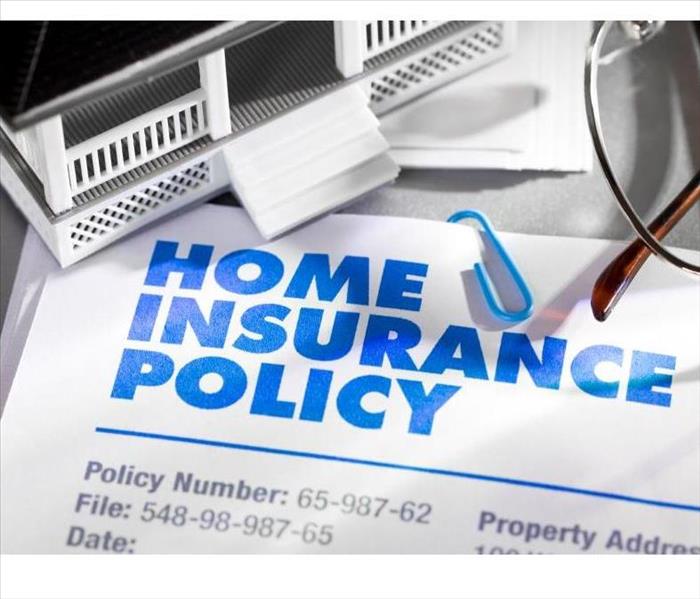 There could be gaps hidden inside your homeowner's insurance policy.
There could be gaps hidden inside your homeowner's insurance policy.
A Homeowners Insurance policy gives you protection for the actual structure of the home, valuables inside, and your family. However, are you aware that there could be gaps in your policy leaving you paying out of pocket for disasters such as a sump-pump back up or failure, or even flood damage?
It’s true, these types of coverage are not included in your basic homeowner’s policy and require a separate addition in order to provide proper coverage. So what should you do? First, dust off a copy of your policy (or ask your local agent to send you a new one) and check to see if you have an endorsement for Sewers and Drains. This endorsement will give you coverage (generally up to $10,000) if the sump-pump backs up or fails, and floods the basement.
Worried about an actual flood destroying the basement and part of the house? Not a problem, flood insurance is not part of a homeowner’s policy, but may be purchases separately through FEMA. Actual flood insurance can be expensive, so generally people who live in a flood zone purchase flood insurance.
However, if you find that you do not have an endorsement for Sewers and Drains or Flood insurance don’t stress. Simply talk with your local insurance agent and they will be able to help add that on to your existing policy. It takes just a few minutes to make sure your properly covered, and will save you thousands should you ever experience water damage from a sump-pump failure or back-up.
"This Feels Dry" Common Misconception
6/19/2018 (Permalink)
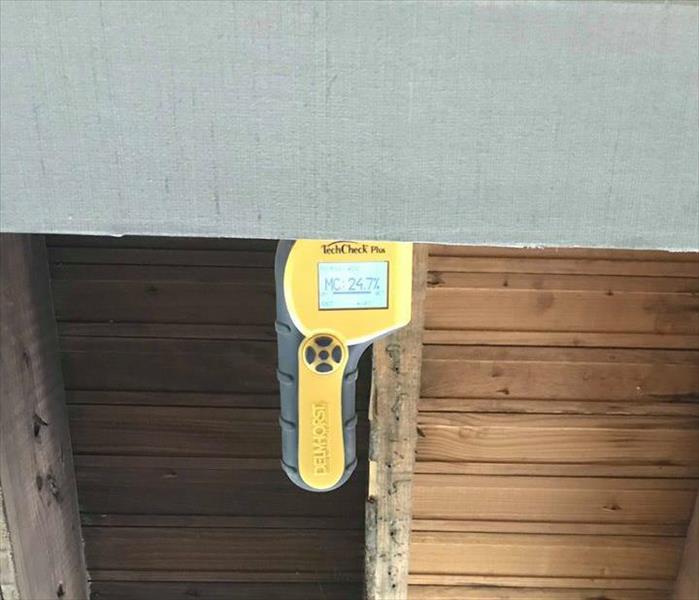 This water meter is just one of several tools we use to ensure things are actually dry.
This water meter is just one of several tools we use to ensure things are actually dry.
After experiencing water damage you most likely have started to remove as much water as possible and begun the drying out process. After some time, you notice things appear to be drying and think, “This feels dry. I don’t need to call someone to do it for me. I’m saving money by doing it myself.”
This is the BIGGEST mistake homeowners make. The truth is even though things feel dry, they actually may still be wet, leading to more damage. When items are not dried properly, the effects of the damage can be more costly than if a professional had dried them. Within minutes water seeps into the floors, walls, upholstery and belongings. If not dried fully and properly there can be several damaging and costly effects. Such as:
- The drywall may begin to swell and brake down.
- Furniture begins to swell and crack.
- Dyes and ink from cloth and paper goods spread and stain.
- Mold and mildew may grow and spread.
- Door, windows and studs swell and warp.
- Paint begins to blister.
- Wood flooring swells and warps.
- Serious biohazard containment is possible.
The professionals at SERVPRO of The Southtowns utilize special equipment to ensure EVERYTHING is dry. Our trained technicians use thermal imaging cameras and water meter sensors to detect water that is unseen. So next time you experience water damage don’t make the mistake of leaving moisture behind. Call the experts at SERVPRO of The Southtowns to make sure the job is done right the first time.
What To Do Until Help Arrives...Water Damage Edition
5/25/2018 (Permalink)
Time is KEY when it comes to water damage, so utilize these helpful tips until help arrives. These tips will help prevent further damage to your valuables and home. But, remember only a professional at SERVPRO of The Southtowns can ensure that your home is dried fully and properly.
DO:
- Remove as much excess water as possible by mopping and blotting.
- Wipe excess water from wood furniture after removal of laps and table top items.
- Remove and prop wet upholstery and pillow cushions for even drying.
- Place aluminum foil or wood blocks between furniture legs and wet carpeting.
- Turn air conditioning on for maximum drying in summer.
- Remove oriental rugs or other colored rugs from wet wall-to-wall carpeting.
- Remove valuable paintings and art objects to a safe, dry place.
- Open and place luggage in sunlight to dry, if possible.
- Gather loose items, toys etc. from floors.
DON”T:
- Leave wet fabrics in place; dry as soon as possible. Hang furs and leather good to dry separately at room temperature.
- Leave books, magazines, or other colored items on wet carpets or floors.
- Use your household vacuum to remove water.
- Use TV or other household appliances while standing on wet carpets or floors. Especially not on wet concrete floors.
- Turn on ceiling fixtures if ceiling is wet, and keep out of rooms where ceilings are sagging from retained water.
How Much Time You Have When Water Damage Is Found
4/12/2018 (Permalink)
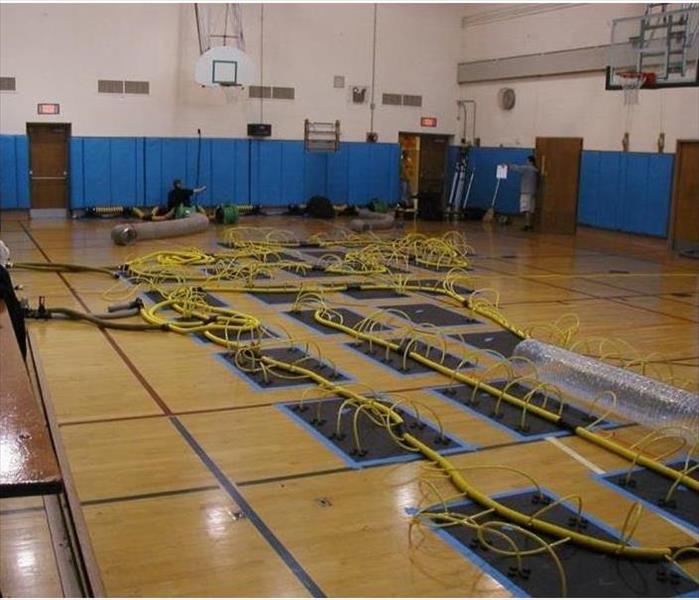 Even hardwood floors may be salvaged.
Even hardwood floors may be salvaged.
If a pipe bursts or a water line begins to leak, the damage starts immediately. It is important to start the mitigation and drying process as soon as possible. Here is a timeline to show just how invasive and devastating water damage can be.
Water Damage Timeline
Within Minutes
- Water quickly spreads throughout your property, saturating everything in its path.
- Water is absorbed into walls, floors, upholstery, and belongings.
- Furniture finishes may bleed, causing permanent staining on carpets.
- Photographs, books, and other paper goods start to swell and warp.
Hours 1 - 24:
- Drywall begins to swell and break down.
- Metal surfaces begin to tarnish.
- Furniture begins to swell and crack.
- Dyes and inks from cloth and paper goods spread and stain.
- A musty odor appears.
48 Hours to 1 Week:
- Mold and mildew may grow and spread.
- Doors, windows, and studs swell and warp.
- Metal begins to rust and corrode.
- Furniture warps and shows signs of mold.
- Paint begins to blister.
- Wood flooring swells and warps.
- Serious biohazard contamination is possible.
More Than 1 Week:
- Restoration time and cost increase dramatically; replacing contaminated materials and structural rebuilding may be extensive.
- Structural safety, mold growth, and biohazard contaminants pose serious risks to occupants.
Valuable Tips for Filing an Insurance Claim for Water Damage
3/8/2018 (Permalink)
 Having to file a claim from water damage is something that is never expected.
Having to file a claim from water damage is something that is never expected.
Having water damage is never something expected. Coming home to a house filled with water can be a traumatic experience. It can be hard to think about the appropriate steps to take to resolve the issue as quickly as possible to limit secondary damage and keep the out of pocket cost to a minimum. Below are some tips to help make filing an insurance claim easier.
Something to Know:
Every insurance policy is different. Therefore, what will be covered may only be determined by reading your policy or calling your insurance agent/insurance company to have them determine coverage.
Knowledge is Power:
Be sure you know who your insurance company is and how to contact them. You may want to list the phone number for your insurance company on your refrigerator for easy access. You could also add your insurance company's 24 hour emergency contact number to your cell phone to have ready at all times. You never know when this information is going to be important.
Stay Calm:
This experience can be upsetting. It's important to stay calm when you are talking to your insurance company so they can ask all the essential questions to set up your claim and get the ball rolling.
Take Pictures:
Document the situation every step of the way to help your insurance company understand the full extent of the damage. Take pictures of every room that sustained damage, structural materials affected and personal items. These pictures will help your adjuster understand the full picture of what happened and what will be involved in restoring your house and the contents affected.
Ask Questions:
Resolving the water damage issue can be very confusing. Feel free to ask as many questions as you can think of to your insurance company so that you understand what will happen next every step of the way. It's important to know what your roles are and what your insurance company will be doing for you.
Use a company with IICRC Certified Technicians:
While there are many companies that may be willing to help you clean up from your water damage, it is important to utilize a company that has technicians who have been trained to properly perform mitigation. SERVPRO prides itself on the fact that our technicians are IICRC certified. Our technicians go through on-the-job training and complete IICRC training so that we can keep up with the latest techniques and technologies to dry your home out quickly to eliminate further damage. Education and training is very important to satisfying our customers. http://www.IICRC.org/education-certification/
What To Do After A Pipe Bursts
1/19/2018 (Permalink)
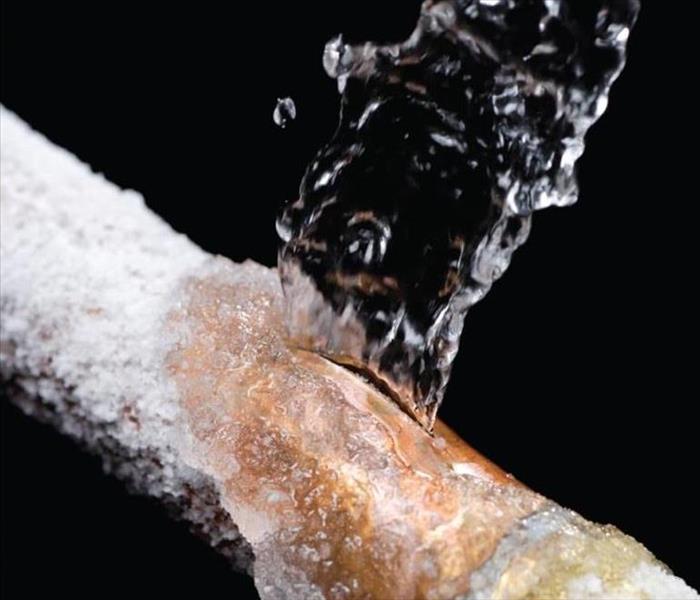 The steps you take after a pipe burst are critical. Time matters when it comes to water damage.
The steps you take after a pipe burst are critical. Time matters when it comes to water damage.
This has been the coldest winter on record in twenty-two years, and it’s only January. Therefore, it is no surprise that we have seen an increase in calls regarding frozen and burst pipes. Tips on how to prevent your home’s pipes from freezing have been all over the media (including the news, our blog and social media), but what should you do if a pipe actually bursts? Here are four helpful tips that you should follow if you experience a burst pipe this winter.
- Shut off the main water valve immediately- This step is critical, as it stops the flooding at its source. Make sure you know where your main water shut off valve is. Pro tip: try tagging the shut off valve so it is easy to spot.
- Turn off the electric supply- This only applies if the main electrical is not wet. Never touch the electric if you are not sure, call an electrician instead. Do not turn on any TV’s or ceiling fixtures.
- Call a professional to begin mitigation right away- Time is key when it comes to water damage and restoring personal items. You can create a barrier between wet carpet and furniture with aluminum foil to prevent further damage until help arrives.
- Remove undamaged items from the affected area- To prevent further damage to removable items, take them out of the affected area and allow them to begin drying.
Should you come home to a burst pipe this winter, give the experts at SERVPRO of The Southtowns a call at 716-646-6684 to begin mitigation immediately, and truly make it “Like it never even happened.”
Why Choose SERVPRO - Right Product, Right Job
6/19/2017 (Permalink)
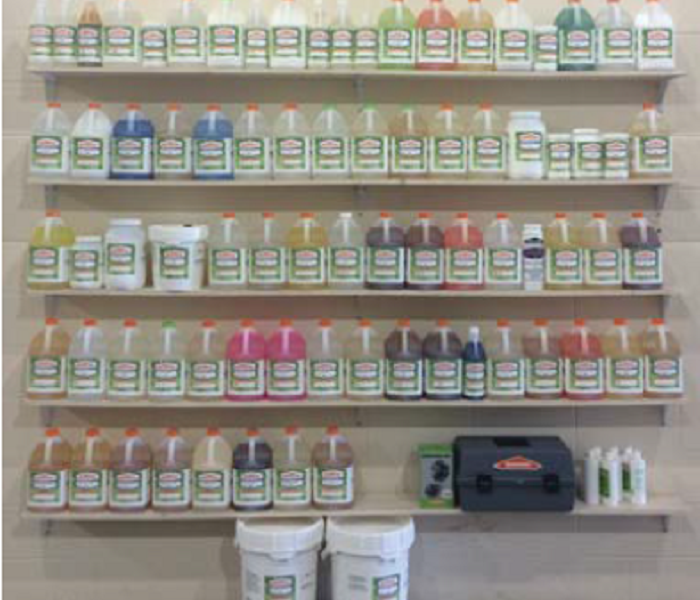 SERVPRO product line
SERVPRO product line
The right equipment and product for the job means everything. When you call on SERVPRO of The Southtowns you can feel secure that the products and equipment we bring into your home or work place are the best in the industry for your specific needs.
Here at SERVPRO, we have an on-staff chemist that has created a custom line of cleaning products based on experience and knowledge from over 40 years in the restoration industry.
The SERVPRO line of Professional Cleaning products has over 150 individual products each specifically formulated to get the job done right. Each product has an available MDS sheet so you know exactly what compounds are in your environment and we can avoid allergens. We also have a complete line of natural and sustainable products.
DryBook Mobile
6/19/2017 (Permalink)
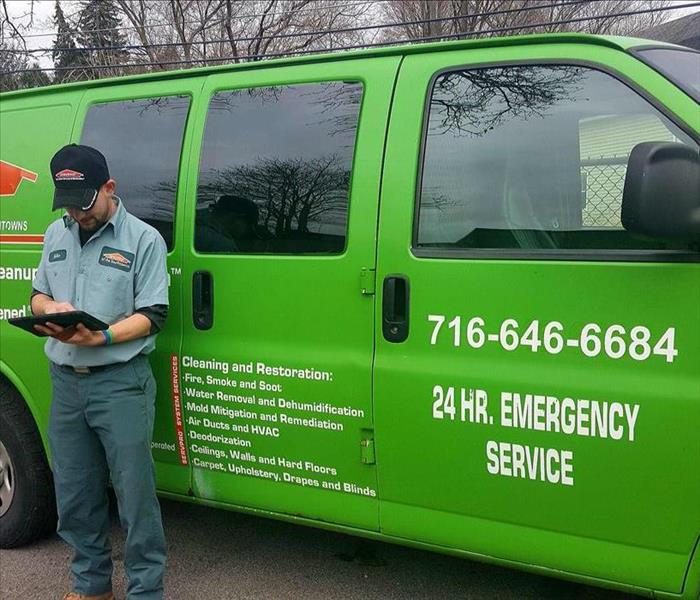 DryBook Mobile helps make our job sites "paper-lite"
DryBook Mobile helps make our job sites "paper-lite"
DryBook Mobile is making our job sites "paper-lite" as we transition more daily paperwork to the iPad.
All of our crews are being trained on DryBook Mobile to create a job process that is transparent and honest.
DryBook mobile is the proprietary program designed and used throughout the SERVPRO franchise system. The program includes floor plans of areas that we are working in, water meter reading or wet areas to show the progression of drying, and equipment formulas based on room size and type of water damage to determine the appropriate amount of dehumidifiers and air movers to remove excess moisture in a timely manner.
SERVPRO of The Southtowns is the restoration company you can count on for over 20 years in Western New York. Call us today for all of your fire, water, mold, and bio-hazard clean up needs.
Water Damage - Home Emergency Tips
5/30/2017 (Permalink)
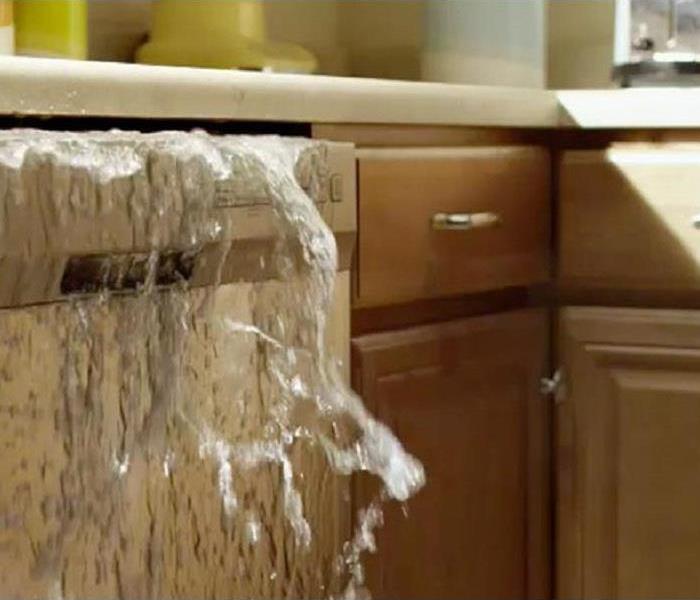 Water damage happens when you least expect it, be prepared with this knowledge!
Water damage happens when you least expect it, be prepared with this knowledge!
DO:
- Remove as much excess water as possible by mopping and blotting
- Wipe excess water from wood furniture after removal of laps and table top items
- Remove and prop wet upholstery and pillow cushions for even drying
- Place aluminum foil or wood blocks between furniture legs and wet carpeting
- Turn air conditioning on for maximum drying in summer
- Oriental rugs or other colored rugs from wet wall-to-wall carpeting.
- Remove valuable paintings and art objects to a safe, dry place.
- Open and place luggage, in sunlight to dry, if possible.
- Gather loose items, toys, etc. from floors.
DON'T:
- Leave wet fabrics in place; dry as soon as possible. Hang furs and leather goods to dry separately at room temperature
- Leave books, magazines, or other colored items on wet carpets or floors
- Use your household vacuum to remove water
- Use TV or other electric appliances while standing on wet carpets or floors, especially not on wet concrete floors.
- Turn on ceiling fixtures if ceiling is wet, and keep out of rooms where ceilings are sagging from retained water.
Water Damage Alarm
3/3/2017 (Permalink)
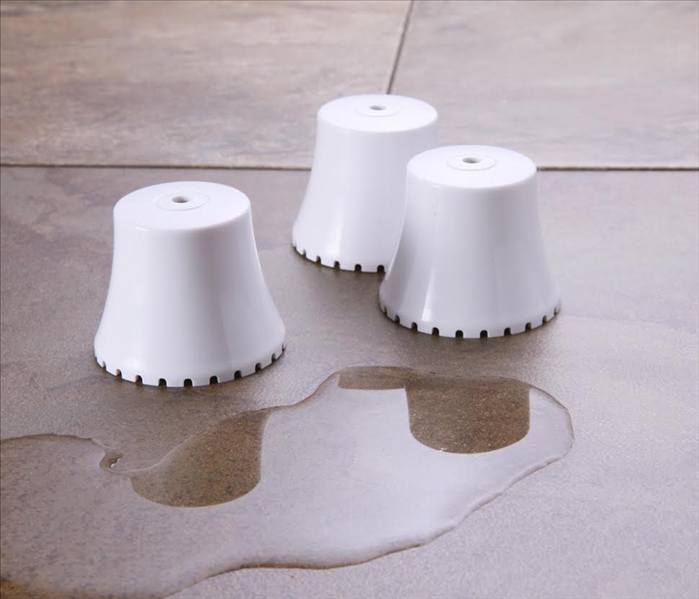 Many of the water damage alarms cost anywhere from $12-$50. When you think about the cost it may save you in the long run, it’s well worth the money!
Many of the water damage alarms cost anywhere from $12-$50. When you think about the cost it may save you in the long run, it’s well worth the money!
What if we told you there was something you could hook up in your home that would alert you when water penetrated an area of your home you didn’t want it to?
Worried about your dishwasher leaking? Concerned about your water heater being old and water seeping out of it? Nervous about having your sump pump fail? Having an alarm that would sound if water infiltrated an area that it was not suppose to be could be helpful in many different spaces in a home or business. If there is an area of your home that has had previous water damages that you may be worried about happening again this water damage alarm could make you feel more comfortable.
If there is a space in your home that you don’t go often, this alarm would notify you of any water damage that occurs. Often, people have areas of their homes they don’t go into on a daily basis. For example, many people don’t or can’t go into their basement every day. Water damages occur in these areas and sit for long periods of time without being noticed. In the mean time, secondary damage occurs. Mold grows, contents get ruined and the already expensive damage becomes a lot more expensive than if it was discovered at the time of loss.
While browsing Amazon.com I found that many of the water damage alarms cost anywhere from $12-$50. When you think about the cost it may save you in the long run, it’s well worth the money! Consider purchasing one (or a few) of these alarms in your home to alert you of a water damage.
Shut off the water!
4/11/2016 (Permalink)
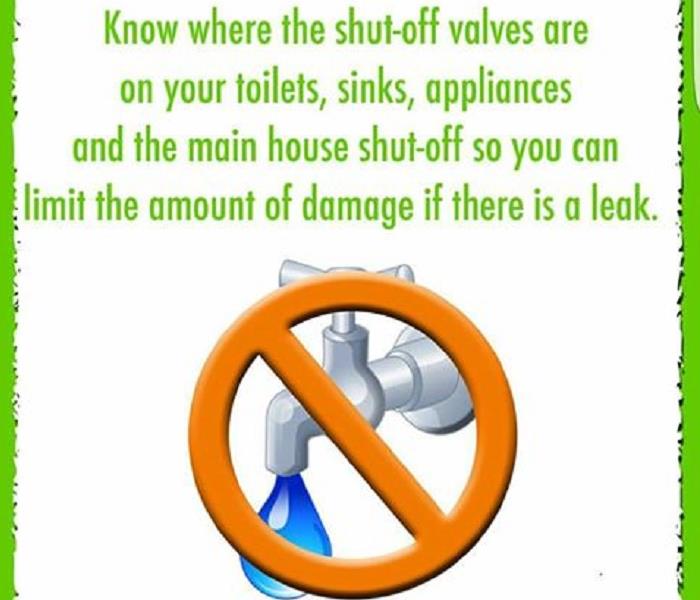 Know your shut off valve
Know your shut off valve
Home Tip: Know where the water shut off valves are on your toilets, sinks, appliances, and the main house shut off so you can limit the amount of damage if there is a leak.
Extra Tip: Add a shut off tag to the main house water shut off so anyone can quickly find it.
Time is of the essence when dealing with water damage, quickly stop the water flow and then call us right away. Water damage can't wait until the morning, that's why we are on call around the clock. When mitigation begins immediately it reduces the risk of mold growth and any further damage.
While you wait for us to arrive begin to remove excess standing water if you can do so safely.
SERVPRO of The Southtowns is on call 24-7 for emergency fire and water damage.
Caption This!
2/16/2016 (Permalink)
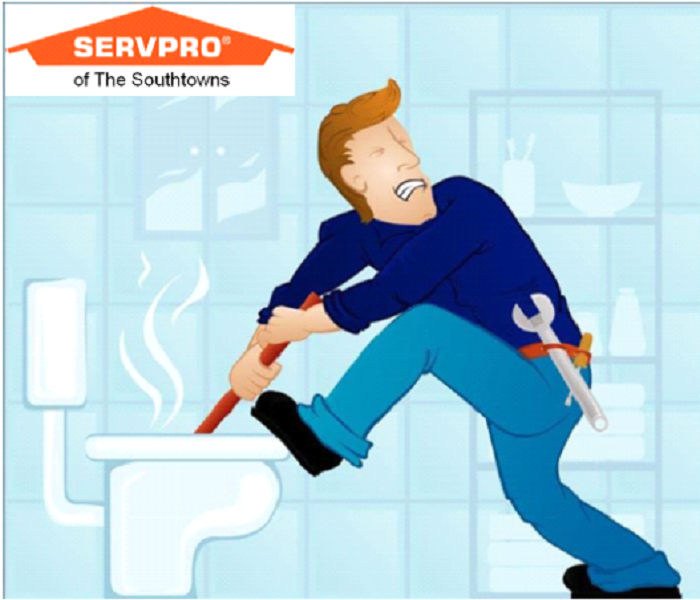 Plumbing Problems?
Plumbing Problems?
Caption this picture!
Water damage from toilet problems can be common. Toilets create a unique type of water because there are multiple sources. Depending on the source the water may be clean category 1 water from a supply line, contaminated category 2 water from the water tank or clean bowl, or grossly contaminated category 3 water from beyond the drain.
Each category of water is handled differently with category 3 water being bio hazard because of the risk to human health.
If you experience water damage from a toilet please call a professional plumber to repair the toilet and a certified technician to mitigate the water damage.
SERVPRO of The Southtowns is on call 24/7 for water damage emergencies. Our heroes are faster to any size disaster, day or night.






 24/7 Emergency Service
24/7 Emergency Service
















